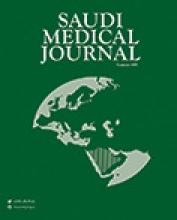Abstract
OBJECTIVE: The primary aim of this study was to investigate the effect of birth intervals on some aspects of intellectual ability of Saudi primary school boys.
METHODS: This is a cross-sectional study of Saudi school children comparing their intellectual ability (general intelligence) in relation to the length of the birth interval before and after the birth of the index child. The study area comprised 3 townships in the eastern province; Khobar, Thogba and Dhahran. The study was conducted in 2000/2001 and the study population comprised Saudi primary school boys aged 9-10 years from a middle class background. A 2 stage random sampling technique was adopted. Data were collected using student data sheet, a family questionnaire and the Standard Progressive Raven Matrices Test of intellectual ability, standardized for use in Saudi Arabia. Data were analyzed using SPSS software.
RESULTS: More than 90% of children born after a birth interval greater than 35 months were classified as average and above according to the Raven Matrices Test, compared to 79% of children born after a birth interval of less than 19 months (p<0.03). Analysis of variance showed that test scores increased consistently as the succeeding birth interval increased. Multivariate analysis showed the most import predicting variables in the Raven Matrices Test to be family income and height.
CONCLUSION: Longer birth intervals were shown to be associated with higher general intelligence levels in the 9-10 year olds. These results confirm those obtained in a previous study in Singapore conducted more than 2 decades ago. Our results have also shown that the succeeding birth interval is more significant than the preceding interval in relation to perceptive ability of children. The findings enable us to advise parents that by observing a birth interval between 2-3 years would make their children grow and do better at school.
- Copyright: © Saudi Medical Journal
This is an open-access article distributed under the terms of the Creative Commons Attribution-Noncommercial-Share Alike 3.0 Unported, which permits unrestricted use, distribution, and reproduction in any medium, provided the original work is properly cited.






